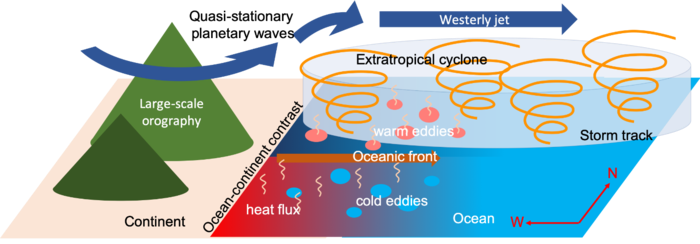The adage “Red sky at night, sailor’s delight. Red sky in the morning, sailor’s warning” indeed remains true. The relationship between atmosphere and ocean can either be smooth sailing or stormy.
 Schematic diagram showing the main factors that can drive changes to the storms: the quasi-stationary planetary waves generated by large-scale orography, the ocean−continent contrast, and the oceanic fronts and eddies. This diagram highlights the role of oceanic fronts and eddies, in addition to the traditionally acknowledged factors. Image Credit: Guidi Zhou.
Schematic diagram showing the main factors that can drive changes to the storms: the quasi-stationary planetary waves generated by large-scale orography, the ocean−continent contrast, and the oceanic fronts and eddies. This diagram highlights the role of oceanic fronts and eddies, in addition to the traditionally acknowledged factors. Image Credit: Guidi Zhou.
Although widescale studies have look into their co-dependence, the impact of sea-air interactions on weather and climate and everything in between has not yet been completely understood, adds a team of researchers based in China.
Guidi Zhou and Xuhua Cheng, both scientists from Hohai University, investigated over 250 papers based on these interactions, with a focus on currents and boundaries in the North Pacific Ocean. There were certain consistent results in the peer-reviewed scientific studies dating from this year to the late 1980s, but the researchers added that more analysis is needed.
The study was published in Advances in Atmospheric Sciences on September 22nd, 2021.
Given the numerous research efforts which sometimes yield conflicting and perplexing results, we believe it is timely to review the currently available studies, make an informative comparison of their results, organize the knowns and unknowns, and try to provide insights for future research.
Guidi Zhou, Hohai University
The researchers focused on studies in the Kuroshio-Oyashio Extension region in the North Pacific Ocean. The warm Kuroshio Extension from the Japanese coast meets with the cold Oyashio Extension from the subarctic sea in this region to form the North Pacific Current.
According to Zhou, in this region, oceanic processes are complex and dynamic because of powerful currents, several ocean fronts marking the divide between water masses and various circular currents that can stretch up to 1,000 km.
The atmospheric storm track and circulation, as well as their interaction, have been extensively studied in meteorology for decades, yet our current knowledge on mesoscale ocean perturbations and their interaction with oceanic jets is still limited.
Guidi Zhou, Hohai University
The mesoscale illustrates the transition between weather and climate, generally including a large area, and can have an impact on a range of weather events. For instance, the same eddy may circulate through stormy or calm areas — but whether the eddy adds to the ensuing weather is not well understood, said Zhou.
“Based on the current understanding of the research, ocean fronts and eddies most likely do impact the atmosphere in terms of driving changes to both weather and climate,” added Zhou said, explaining that the eddies and fronts could even impact atmospheric changes that last about a decade. “Large uncertainties, however, are present and much more in-depth investigation is needed.”
Journal Reference:
Zhou, G & Cheng, X (2021) Impacts of Oceanic Fronts and Eddies in the Kuroshio-Oyashio Extension Region on the Atmospheric General Circulation and Storm Track. Advances in Atmospheric Sciences. doi.org/10.1007/s00376-021-0408-4.
Source: http://english.iap.cas.cn/